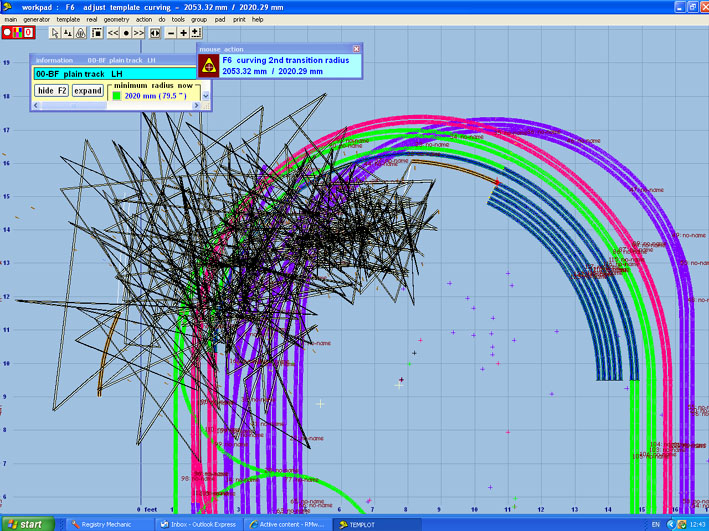Templot Club Archive 2007-2020
|
|||
| author | remove search highlighting | ||
|---|---|---|---|
|
posted: 3 Dec 2011 23:10 from: Rob Manchester
click the date to link to this post click member name to view archived images |
Hi Martin, I managed to get some strange patterns on the screen today when adjusting the the 1st and 2nd radius of a transition curve. The 'errors' occur when finely adjusting the radius. You can work through it by going just a bit further on when the display returns to normal. TDV doesn't crash at all. It is hard to re-produce the problem but if I do I will stop and leave everything where it is while saving the templates in a box file for you. One of the screenshots is attached. Anybody else seen this ? Rob |
||
| Attachment: attach_1256_1715_Transition_crash_1.jpg 303 | |||
|
posted: 4 Dec 2011 05:31 from: Martin Wynne
click the date to link to this post click member name to view archived images |
Hi Rob, Thanks for posting the file. It's a long-standing known issue, not related to TDV. Essentially you created a transition curve which was too gentle for the maths processor in your computer. "Too gentle" means the radius was changing by too little in too long a transition zone. The problem will disappear as soon as you change one of the radii, or shorten the transition zone. Generally when this happens you can split the difference in radii and replace the transition with a fixed radius curve. Often the screen is more alarming, and you can create some startling effects, like this one from Gordon S: 479_260758_150000000.jpg  It's difficult for me to prevent, without restricting the necessary functionality. One day I may have a fresh look at the transition maths -- I wrote the transition code many years ago. Once you know about it you can just ignore it. More about it here: topic_1391&forum_id=4 regards, Martin. |
||
|
posted: 4 Dec 2011 15:53 from: Rob Manchester
click the date to link to this post click member name to view archived images |
Hi Martin, Thanks for the reply. I tried to reproduce the problem with 0.91 but couldn't so wasn't sure if it related to the TDV or not. Mind you it wasn't easy to reproduce in TDV either. Attached is one of the other screenshots I took at the time. I though my track laying was poor ! Thanks again. Rob |
||
| Attachment: attach_1257_1715_Transition_crash_2.jpg 294 | |||
|
posted: 4 Dec 2011 17:54 from: Les G click the date to link to this post click member name to view archived images |
Hi guys, Having read of this "problem" first time around, and to avoid a third ( or by then, maybe fourth) repeat in a few months time... How about re-naming this topic. For example: " Not a Templot transition problem " ? After all, Martin has much he wishes to do, and repetitively going over old ground can be a classic blood pressure raiser. That said, praise for another patient explanation in Martin's excellent style Les G |
||
|
posted: 5 Dec 2011 13:36 from: gsmorris click the date to link to this post click member name to view archived images |
Agree an alarming fact,but not the tensing and avoidable. This has been asked about a number of time, by me also. Let's rename the tread!. On a serious note searching through the archives mostly give the answer wanted. Martin has been saintly in his answered over he years. Can I suggest a banner saying search first ask second? |
||
|
posted: 5 Dec 2011 22:22 from: Rob Manchester
click the date to link to this post click member name to view archived images |
Sorry Martin, Search first, start a new topic if can't find the answer.... In fairness though any of us Templot users could have replied before Martin did. He is so quick off the draw. Maybe he should set the system up so he doesn't see the messages for 24 hours - give us all a chance to reply first! Rob |
||
| Please read this important note about copyright: Unless stated otherwise, all the files submitted to this web site are copyright and the property of the respective contributor. You are welcome to use them for your own personal non-commercial purposes, and in your messages on this web site. If you want to publish any of this material elsewhere or use it commercially, you must first obtain the owner's permission to do so. |